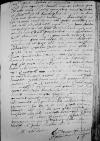List #6253
Ioannes DANTISCUS do [Sigmund von HERBERSTEIN]Sitzendorf an der Schmida, 1532-07-16
Rękopiśmienne podstawy źródłowe:
Publikacje:
| ||||||
Tekst + aparat krytyczny + komentarz Zwykły tekst Tekst + komentarz Tekst + aparat krytyczny Ekscerpty dotyczące podróży Dantyszka
Magnifice Domine, salutem et commendationem plurimam.
Cum huc appulissem tandem laqueo contrito cf. Vulg. Ps (G) 123:7 ⌊anima nostra quasi avis erepta est de laqueo venantium laqueus contritus est et nos liberati sumuscf. Vulg. Ps (G) 123:7 ⌋, quo iam octo annis et quinque mensibus fueram vinctus[1], et magnificus dominus Rudolphus de Hefelt[2] in domo sua me humanissime tractasset diceretque se ad Magnificentiam Vestram cras iturum, non potui omittere, quin Magnificentiae Vestrae et absolutionem meam ex hoc tam diuturno ergastulo et hanc benevolentiam, qua me bonus iste dominus prosecutus est, declararem. Quam summopere rogo pro iure veteris nostrae amicitiae, quo mihi aliquid Magnificentiam Vestram debere existimo et quo Magnificentiae Vestrae sum vicissim obligatissimus, velit huic bono domino gratias habere, quod Magnificentiae Vestrae veterem amicum adeo in domo sua humaniter tractaverit. Idque mihi non minus erit gratum, quam id, quod gratissimum seque sic erga illum exhibeat, ut cognoscat me (de quo collatus sum) a Magnificentia Vestra amari. Quicquid ... illegible⌈...... illegible⌉ rursus vel in eo vel in casu magis arduo Magnificentia Vestra a me postulaverit, habitura me est propensissimum. Inter eundum a
Dat(ae) or Dat(um)⌈Dat(ae)Dat(ae) or Dat(um)⌉
ex villa
Magnificentiae Vestrae deditissimus

 OSK, Fol. Lat. 258, f. 241r
OSK, Fol. Lat. 258, f. 241r